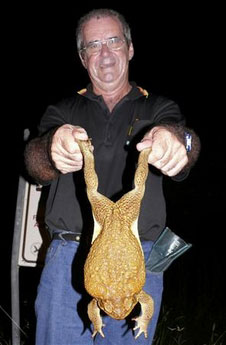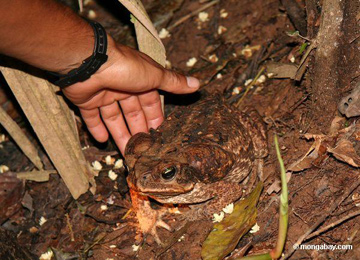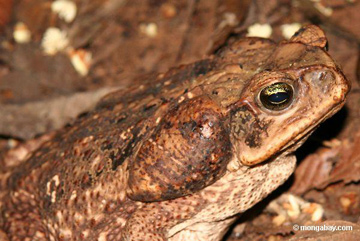Invasive Species: Toad-ally out of control
Ryan King, special to mongabay.com
May 18, 2008
|
|
The ongoing epic of the cane toad foretells a grim future for ecologically sound management of introduced organisms
Throughout warm, wet climates around the world lurks a camouflaged combatant seldom known beyond those who experience first hand its awesome destructive powers. It is an ingeniously crafted destroyer equipped with a host of specially developed chemical toxins, a lightening fast attack, and the ability to easily navigate across both water and land.
This devious tool is not a creation of human engineering or military research and development but a product of a much more ancient and refined process: evolution. And until human intervention it was neither ecologically harmful nor an invasive pest but a well-integrated part of ecosystems throughout South and Central America.
Meet Bufo marinus — the cane toad: exemplary proof of how human short-sightedness and misuse of biological control agents often leads to the catastrophic mismanagement of our natural world in the form of a large, squat, hungry toad.
Tale of the Toad
 Bob Goninon of FrogWatch Australia holds a large cane toad captured near Darwin in Australia’s Northern Territory March 26, 2007. Courtesy of FrogWatch |
About a century ago it became popular to export cane toads from their native habitats in Central and South America to be used as biological pest control in sugar cane fields. The toads were introduced for this reason in 1935 to northern Queensland, Australia. The ecological consequences have been and continue to be devastating. The original shipment of 100 toads from Hawaii soon exploded into tens of thousands, which spread outward across Northern Australia at rates between 27-50 kilometers each year (1).
The toads were intended to function as predators for a population of scarab beetles that were damaging Australian sugar cane crops. Shortly after the introduction of a small population of cane toads it became evident that the ground-dwelling amphibians were unable to fly, climb, or otherwise scale the sugar cane in order to prey on the beetles which lived in the upper portions of the plants (1).
The toads, however, proved to be adept and voracious predators to almost everything except the beetles. Though large, slow, and relatively clumsy on land cane toads have many physiological features which make them well fit to survive and prosper in the right environment. The toads consume virtually anything they can gulp down: small mammals, other amphibians, snails, terrestrial and aquatic insects, and even dog and cat food. Female cane toads may lay between 5,000 and 30,000 eggs, and adults of both sexes are equipped with a chemical defense know as Bufotoxin to discourage predation. Their robust adaptations to tropical environments and large appetite soon led to an all out invasion of the Australian habitats, which harbored no natural predators able to circumvent the cane toad’s strong toxic defense.
In addition to creating substantial negative impacts on the native wildlife of Australia, the toads are also known to transmit diseases that effect humans, such as salmonellosis (1, 2). The toads are capable of out competing native amphibians and other vertebrates for resources, poisoning and injuring humans and pets, and spreading diseases and infections between native amphibian and fish populations. Observations of Bufotoxin-linked deaths in Australian native wildlife including monitor lizards and various snakes indicate that the toads pose a “direct and indirect… threat to native Australian fauna” (7). Worldwide, the cane toad ranks among the IUCN’s (The World Conservation Union) “100 World’s Worst” invasive species.
The Human Role in the Spread and Control of Invasive Species
 Cane toad is its natural habitat in the Amazon rainforest |
The introduction of invasive species by humans, whether it be intentional as in the case of the cane toad in Australia, or accidental ranks second to habitat loss as the leading cause of wildlife endangerments and extinctions worldwide (7). Invasive species span all taxonomic groups: plants, animals, and microorganisms. A species is labeled an invasive if it is “non-native (or alien) to the ecosystem under consideration” and if its “introduction causes or is likely to cause economic or environmental harm or harm to human health.” These introduced organisms typically alter their new environment by out competing natives for resources, directly damaging industrial and agricultural resources, and by contributing to general disturbance of formerly stable ecosystems (3, 4).
Invasive species are sometimes introduced by accident; spread by fault of humankind’s ability and desire to constantly explore, trek and penetrate the furthest reaches of our biosphere. Documented cases even exist of spread of invasive species into natural habitats by unaware scientific researchers (4).
While accidental introductions play a significant role, it is the directed, technological development and use of biological control agents that has potential for ecological disasters orders of magnitude greater than these cases. As biological control technology increases and diversifies so does its potential for harm. Engineered viruses, genes, and purposefully introduced species continue be developed and applied with little or no consideration of their long-term ecological effects. The past and present history of our mismanagement of biological controls implores drastic shifts in approach and application. The evolving perspective of systems ecology and environmental science advocates prudence and restraint in our attempts to administer anthropogenic alterations into naturally regulated ecological cycles (9).
Economic costs of the introduction of invasive species in the United States averages between 137-138 billion dollars a year (6, 7). These annual expenditures include only the direct destruction by invasive organisms and control costs. Economic losses wrought by the overall effects of invasions are actually much greater and include the expenses of losses in agricultural production, declines in biodiversity, and disruption of ecosystem services among many other factors (5, 6).
Looking forward, acting backwards
If the last hundred years of anthropocentric bumbling of the management of the cane toad in Australia serve as an illustration of our past ill-fated attempts to supervise the natural world, we might consider future proposed efforts to determine if the tale of the toad has provided insight significant to cause a shift in approach.
The Australian Government Department of Environment and Heritage offers little hope for an altered stratagem:
“Scientists at the CSIRO Animal Health Laboratory in Victoria, Australia have been searching for biological controls of B. marinus and in 2001 they began investigating gene technology as a mechanism of control. There is hope that a pheromone will be found in B. marinus and that it could be used to disrupt their breeding cycle.”
“At present there is no broadscale method available to control cane toads in Australia. Researchers are attempting to identify a biological control agent, such as a virus, that is specific to cane toads” (8).
So Australia’s plans for halting the advance of the invasive toad which was introduced by humans as an ineffective biological control for a pest problem occurring in monocultures of sugar cane is to engineer and introduce genetic mechanisms to drastically alter its breeding population, or to spread a virus through the population. A shift in approach has not occurred but merely another step in the same direction using increasingly sophisticated and convoluted biological control agents to fight at the frontlines of our ecological battles. Just as earlier generations applied the cane toad as a biological control under assumptions which proved to have serious detrimental environmental and economic consequences so continue current efforts in the unchecked development and application of biocontrol agents. The effects of pheromones from engineered and introduced genes on other amphibians or the ability of an introduced virus to affect other organisms will not be known until after application, at which point it may be too late to control.
Another Angle on Invasives
 Cane toad is Peru |
Harvard professor, Pulitzer Prize-winning author, and expert biologist E.O. Wilson claims humankind’s historical role as “the planetary killer” began some “fifty to ten millennia ago, with the ascent of Upper Paleolithic and Neolithic peoples, whose improved tools, dense populations, and deadly efficiency in the pursuit of wildlife inaugurated the current extinction spasm” (9). Until the development of environmental sciences humans have had virtually no methods to survey their past and present roles in the biosphere. We are now becoming aware of the effects of our widespread disruption to nature and their consequences, and struggling to alter our course.
The World Conservation Union (IUCN) defines an invasive species as “organisms (usually transported by humans) which successfully establish themselves in, and then overcome, otherwise intact, pre-existing native ecosystems. The IUCN’s list of the top 100 worst invasives, however, is lacking its most obvious candidate: Homo sapiens. Until we recognize our own role in the accidental and intentional spread of invasive species and the litany of other damages to organisms and natural cycles which sustain life on Earth, it seems likely that we will continue hopping obliviously down the path towards an unstable planet.
The first steps toward mediating the environmental catastrophes of the introduction of destructive non-natives is confronting the reality that humankind is virtually always the invasive species responsible for their introduction, and that we have the ability to alter our course through lifestyle and policy change. Our own ability to begin to acknowledge our maladaptive behaviors coupled with the destructive potential of our technologies and alter our course will surely play a crucial role in the near-future fate of life on our planet. The necessity of changing from the disorganized, piecemeal approach of attempting to manage our environmental issues by solely technological manipulation is abundantly clear; the time has come for humankind to shift its blame from the toads to the real trouble maker behind virtually all invasions: ourselves.
1.http://www.environment.gov.au/biodiversity/invasive/publications/cane-toad/index.html The Feral Cane Toad: Bufo Marinus. Australian Government Department
2.http://edis.ifas.ufl.edu/UW046 Marine Toads. Univesity of Florida
3.http://www.issg.org/IUCN The World Conservation Union — Invasive Species Specialist Group
4. GAO, “Invasive Species: Clearer Focus and Greater Commitment Needed to Efficiently Manage the Problem, GAO-03-1 (Washington, DC.: Oct. 22,
2002); “Invasive Species: Federal and Selected State Funding to Address Harmful, Nonnative Species, GAO/RCED-00-219 (Washington, D.C.: Aug.
24, 2000).
5.http://www.invasivespeciesinfo.gov/
States Department of Agriculture National Agriculture Library. National Invasive Species Information Center.
6. Pimentel, D., et al. 2001. Economic and environmental threats of alien plant, animal, and microbe invasions. Agriculture, Ecosystems & Environment 84(1): 1-20.
7. Pimentel, D., R. Zuniga and D., Morrison. (2005). Update on the environmental and economic costs associated with alien-invasive species in the United States. Ecological Economics 52:273-288.
8.http://www.columbia.edu/itc/cerc/danoff-burg/invasion_bio/inv_spp_summ/Bufo_marinus.html
Introduced Species Summary Project Giant Marine Toad (Bufo marinus)
9. E. O. Wilson. “The Diversity of Life.” 1996